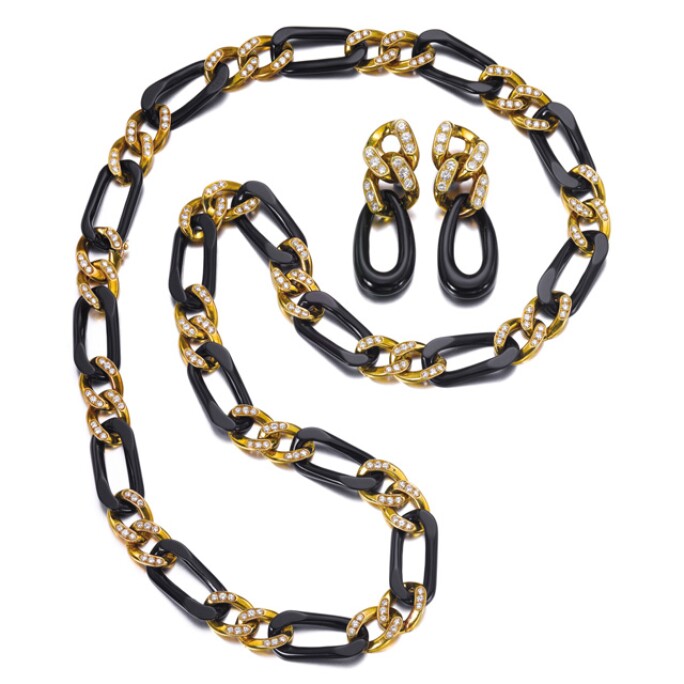
The inaugural GemGenève fair, which is being held in Palexpo in Geneva from 10–13 May, will bring together globally-renowned exhibitors, antique jewellery dealers, gem merchants, jewellers and pearl specialists and is open to both the trade and public. Jewellery historian Amanda Triossi, who has worked at both Sotheby’s and Bulgari during her distinguished career, will be talking at the event about jewellery from the ‘60s and ‘70s. We caught up with her ahead of the talk to find out more and to ask for her selections from the upcoming Magnificent and Noble Jewels auction.
Sotheby’s: The inaugural opening of GemGenève during the major auction houses’ jewellery sales brings together the entire jewellery community from around the world. How does this fair stand out from past jewellery fairs?
Amanda Triossi: There is a lot of excitement and anticipation in the jewellery world for GemGenève as it has been conceived and set up by members of the jewellery trade who are personally aware of all the needs of gemstone and jewellery dealers, hence most aspects have been devised to cater specifically for their requirements. The aim is to make this fair an open and inclusive event: a forum for exchange among professionals, collectors and amateurs regarding all aspects of the "multi-faceted" gem trade. It is also a place to see and find items of great quality and meet people with similar interests. At all levels of expertise it is always important to continue learning and to discover what is new, hence education and sharing knowledge is another important ingredient that will make GemGenève an interesting and exciting event. Last but not least the location can be easily reached from abroad as visitors can arrive at the airport, visit the fair at length and the depart on the same day.

S: What makes jewellery important/significant for you?
AT: Among all the art forms, what distinguishes jewellery and makes it special for me is that it is wearable art made of precious durable materials; for example one cannot wear an Old Master painting but one can definitely do so with a great jewel dating to the same period and look good in it.
S: What are your favourite gemstones and why?
AT: I am afraid I am unable to answer this question as I do not have a specific favourite gemstone. As I have had the opportunity and the great privilege to handle and examine a great variety of fine gemstones I am attracted to quality and rarity rather than a particular type. I may get excited by an exceptional red spinel or a particularly fine demantoid garnet, but this doesn't mean I cannot be equally fascinated by a beautiful ruby or a rich velvety blue sapphire. Some gems just stay in your heart forever, even if one has never owned them; I still remember an orangey yellow pear shaped diamond from the time when I was a very, very junior cataloguer at Sotheby's Geneva in 1987; I hope one day I may be able to see it again! If I am forced to answer your question, I think I probably prefer colour to colourless gems, but as you know diamonds are a girl's best friend so definitely I would not refuse a colourless diamond if the occasion should arise.
S: As a modern woman, how does it feel to wear jewellery from the 60s/70s?
AT: In general a certain category of jewels designed and created in the 1960s and 1970s tend to be big and bold rather than intrinsically very precious. This means one can enjoy wearing them in a more casual manner without the worry of sporting huge diamonds and gemstones. I believe jewels have to be decorative, adding something to the wearer, who has to feel comfortable with a particular style of jewel. Jewels of the '60s and '70s work for me but this doesn't mean that they suit or are everybody's taste or style.
S: More generally, what can modern style learn from retro jewellery?
AT: Jewels are, as all art forms are, the mirror of their time: they are deeply connected to contemporary fashion, artistic movements, technology and the availability of certain precious materials. For example the boom in the second half of the 18th century for diamond set jewellery was largely prompted by the greater availability of diamonds on the market following finds of new diamond mines in Brazil in the 1730s. I think that one has to remember that jewellery is always developing and changing with time but there is also continuity with the past, just think of some goldsmiths' techniques that have remained practically unchanged since antiquity.
Jewels are, as all art forms are, the mirror of their time...
S: In the upcoming Sotheby’s Magnificent Jewels and Noble Jewels auction in Geneva on 15 May, which pieces from the ‘60s and ‘70s stand out to you most?
AT: My personal pick would be lot 157, an onyx and diamond demi-parure, as it is a very representative type and style of jewel of the 1970s. Long chains with matching pendent earrings became fashionable at the time as their elongated line complemented the long maxi dresses that were in vogue during the 1970s. Furthermore yellow gold combined with strong contrasting colours and materials, in this case black onyx links, were used extensively by the top jewellers of day. Van Cleef & Arpels undoubtedly created some great and representative jewels in this style. I love them.
VIEW FULL CATALOGUE OF THE SALE HERE.



